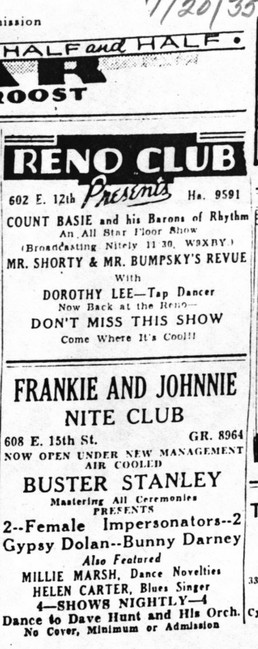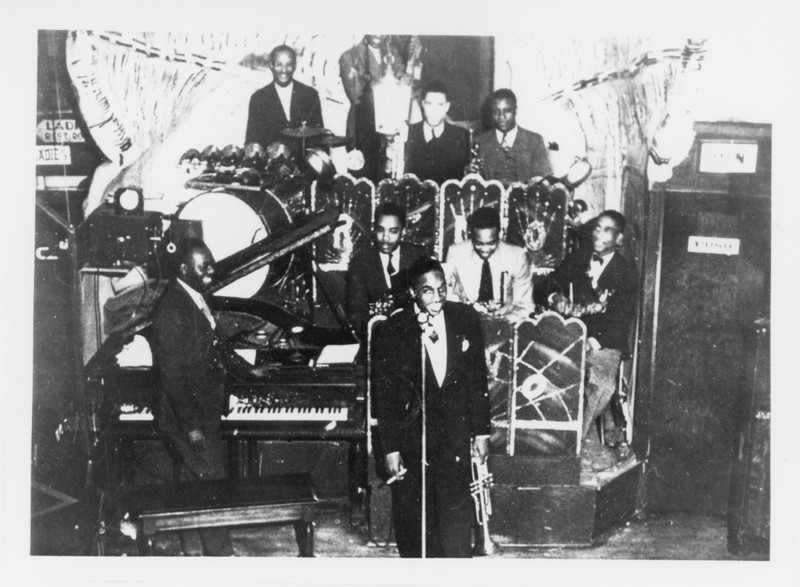12th Street Reno Club (1930s)
Introduction
Text-to-speech Audio
Now a parking lot for the Kansas City Police Department, this was the site of one of the 12th Street Reno Club which was operated by Tom Pendergast. One of Kansas City's leading jazz clubs of the 1930s and home to influential bands like the Count Basie Orchestra, this was one of the most successful jazz clubs during the era when Kansas City's jazz scene thrived under the "protection" of the political machine that dominated the city. When "Boss" Tom Pendergast was sent to prison and reform elements took control of Kansas City, the club closed. But starting in 1931, patrons could see jazz legends such as Count Basie, Charlie Parker, Hot Lips Page, and Mary Lou Williams perform. This was also the location of experimental radio broadcasts that shared the unique form of Kansas City jazz with audiences nationwide. Like many other establishments in the city, the Reno Club was segregated, with the main floor being reserved for white patrons while African Americans were seated in the balcony.
Images
An ad for Count Basie at the Reno Club in 1935

Buster Moten Band at the Reno Club with Hot Lips Page at the microphone

Backstory and Context
Text-to-speech Audio
The historic 12th Street Reno Club was once located here near the northeast corner of 12th and Cherry. Today this location is home to a parking lot, but in the 1930s, it was home to the legendary Reno Club where Jazz Greats such as Count Basie, Charlie Parker, Hot Lips Page, and Mary Lou Williams performed. In 1935, Count Basie first performed with the orchestra that would become the world-famous Count Basie Orchestra and in 1936 experimental radio broadcasts took this Kansas City sound worldwide.
Count Basie recalled “The Reno was not one of those big fancy places where you go in and go downstairs and all that. It was like a club off the street. But once you got inside, it was a cabaret, with a little bandstand and a little space for a floor show, and with a bar up front, and there was also a little balcony in there. There were also girls available as dancing partners. It was a good place to work. I liked the atmosphere down there. There was always a lot of action because there were at least four other cabarets right there on that same block, and they all had live music and stayed open late.”
The Reno Club also had a complicated relationship with the law. The club was owned by the notorious Pendergast family and there was a space behind the club where Pendergast and his associates would meet. The club was also a location for Pendergast associates to deal in drugs and prostitution. As recorded in Nathan Pearsons book, Goin' to Kansas City, John Hammond, the record producer who discovered Basie said of the club, "I'll never forget the first night, I went to the Reno...There was a whorehouse upstairs...and there wasn't enough money for liquor so obviously it would be, everybody grew pot in the backyard in Kansas City. This is how the band was able to exist."
In 1939, the Pendergast Era ended, and reforms swept through the city. Many historic jazz venues were shut down or died out without the support of Pendergast associates, including the historic Reno Club, which shut its doors shortly after Pendergast was arrested for tax evasion. Today, the Kansas City jazz tradition of the 1920s and 1930s continues with numerous venues throughout the city. The Blue Room at the American Jazz Museum and Lonnie's Reno Club in the Ambassador Hotel include regular tributes to Count Basie, Charlie Parker, and other musicians who performed here.
Cite This Entry
Howard, Jake and Clio Admin. "12th Street Reno Club (1930s)." Clio: Your Guide to History. August 4, 2024. Accessed March 29, 2025. https://theclio.com/entry/148548
Sources
Driggs, Frank, and Chuck Haddix. 2005. Kansas City Jazz : From Ragtime to Bebop--a History. Oxford University Press. https://search-ebscohost-com.proxy.library.umkc.edu/login.aspx?direct=true&db=cat07616a&AN=umk.b5199034&site=eds-live&scope=site.
Pearson, Nathan W. Goin’ to Kansas City. University of Illinois Press, 1987. EBSCOhost, https://search-ebscohost-com.proxy.library.umkc.edu/login.aspx?direct=true&db=cat07616a&AN=umk.b1999332&site=eds-live&scope=site.
, KC Jazz Ambassadors. The Reno Club, Back in the Day, November 30th, 2020. Accessed March 27th, 2023. http://www.kcjazzambassadors.org/post/the-reno-club-back-in-the-day.
http://www.kcjazzambassadors.org/post/the-reno-club-back-in-the-day
Kansas City Museum Union Station, KCMA-PC35-1192

